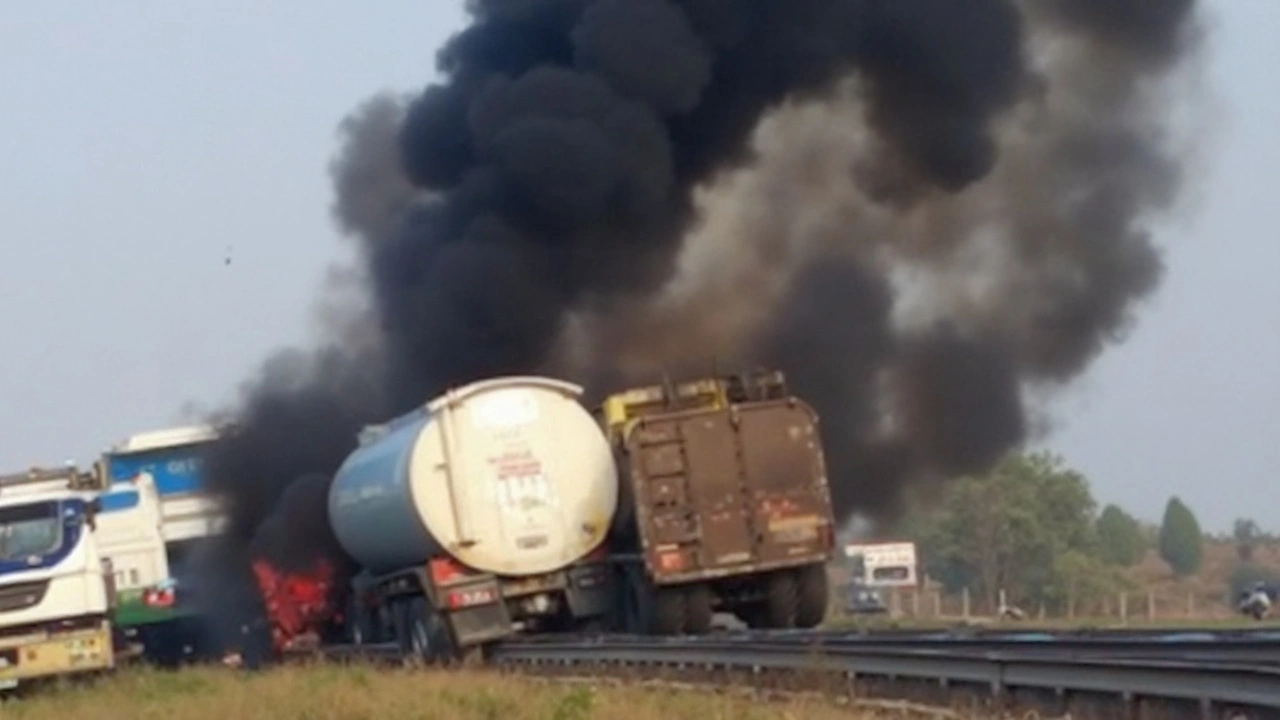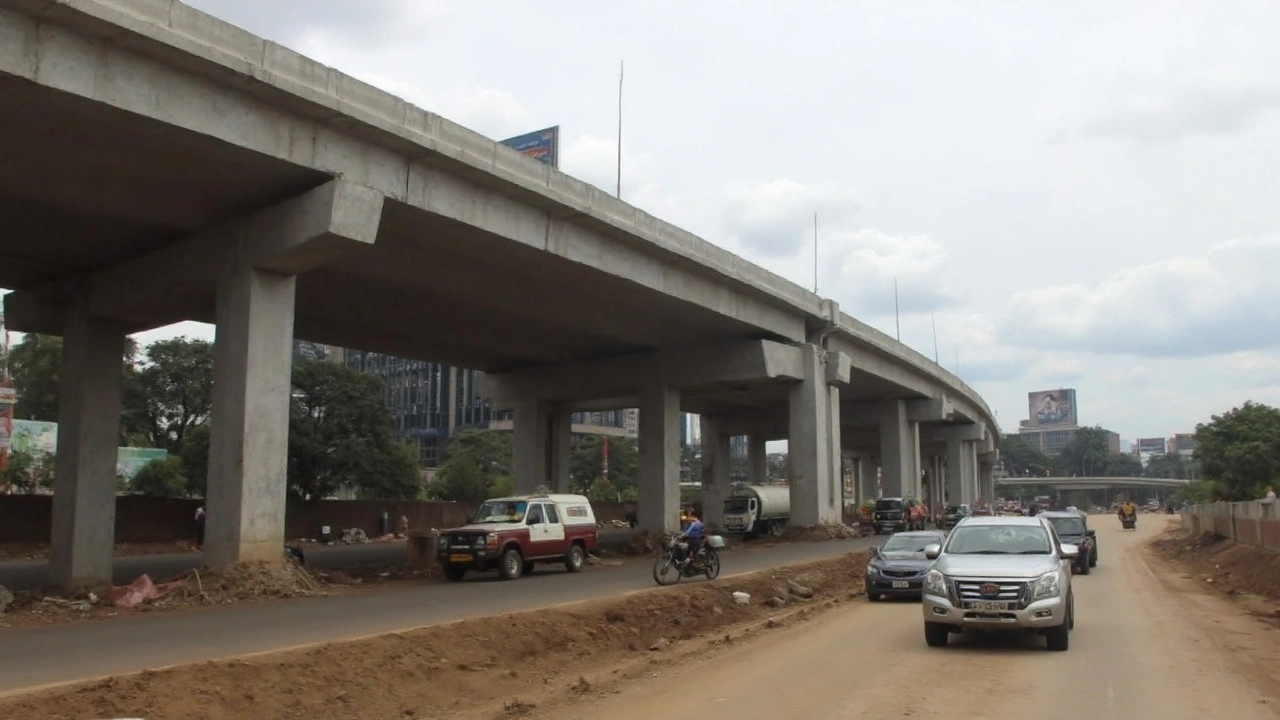Nairobi-Mombasa Highway Crash: Tanker and Lorry Collision Sparks Massive Blaze, Fuels Safety Debate
 Jul, 13 2025
Jul, 13 2025
Highway Blaze Leaves Drivers Stunned and Roads Blocked
Early in the morning of March 20, 2025, the Nairobi-Mombasa Highway—which millions rely on for travel and trade—was suddenly engulfed in chaos near the small town of Mtito Andei. A fuel tanker and a lorry smashed into each other, and within moments the wreckage was consumed by flames shooting high above the tarmac. The fireball forced a partial closure of one of East Africa’s most vital roadways, leaving a line of stranded vehicles and drivers rattled by what they had just witnessed.
Eyewitnesses described a terrifying scene as the crash unfolded. The immediate aftermath saw plumes of thick black smoke and a lingering fear that lives had been lost, though, as the hours ticked by, officials said they had not yet confirmed any deaths. Emergency responders rushed to contain the blaze, struggling to prevent the highly flammable fuel from spreading the fire further or igniting other vehicles on the packed highway.

Trouble on Kenya’s Lifeline: Old Problems, Dire Consequences
This stretch of the Nairobi-Mombasa Highway has built up a notorious reputation. Crashes involving heavy trucks and tankers are hardly rare, and conversations with local drivers paint a grim picture: high speeds, reckless overtaking, and a stubborn disregard for simple safety rules are the norm, not the exception. The latest incident is a grim reminder of those ongoing challenges, turning another ordinary drive into a disaster scene within seconds.
Tragic as it may be, many truckers and bus drivers admit that pressure to deliver goods on tight schedules encourages dangerous behavior. Passing slower vehicles on blind curves and ignoring traffic rules might save a few minutes—but it often ends in chaos. According to the Kenya National Bureau of Statistics, fatal road accidents have climbed steadily over the past three years, with the Nairobi-Mombasa route representing a significant share of those deadly numbers.
Authorities were quick to respond following the Nairobi-Mombasa Highway fire, setting up diversions and urging caution, but some bystanders wondered aloud whether tougher laws or more patrols would truly change things. The families of those caught up in Wednesday’s crash are left waiting for news, hoping for the best but haunted by the possibility of tragic outcomes. This dangerous stretch of road, linking the bustling capital to the busy Port of Mombasa, needs urgent answers before another catastrophe turns panic into heartbreak.

mary oconnell
July 13, 2025 AT 18:10Well, folks, another textbook case of systemic risk on Kenya's arterial lifeline, complete with fuel‑laden super‑structures colliding like errant variables in a poorly‑debugged codebase. The juxtaposition of reckless overtaking and lax enforcement is a perfect illustration of what I like to call “policy inertia meets driver myopia.” If we, as a collective, could internalize the cascading externalities of each shortcut, perhaps the next incident would be a footnote rather than a headline. Remember, safety isn’t just a checklist item; it’s the emergent property of a culture that values lives over delivery windows. So, next time you’re tempted to shave off five minutes, consider whether you’re contributing to a statistical outlier or a predictable disaster.
Michael Laffitte
July 15, 2025 AT 19:20Totally feel you on that, Mary-it's like watching a chaotic ballet where the dancers forgot the choreography. The sheer audacity of those truckers to race the clock, disregarding the physics of momentum, makes my heart race faster than their engines ever could. I’m all for tightening the regulatory nets, but we also need grassroots awareness campaigns that actually stick in the drivers' heads. Let’s hope the authorities finally upgrade the enforcement algorithms before the next fireball lights up the highway. In the meantime, kudos to the first responders who turned a potential inferno into a controllable blaze.
sahil jain
July 18, 2025 AT 02:53Seeing the devastation on the Nairobi‑Mombasa stretch is a stark reminder that every mile traveled carries a responsibility. As drivers and cargo operators, we have the power to turn this narrative from one of tragedy to one of resilience. Prioritizing scheduled maintenance, respecting speed limits, and planning realistic delivery windows can dramatically cut down the risk of such catastrophic collisions. Let’s champion a safety‑first mindset that empowers every stakeholder, from the truckers to the dispatchers, to make smarter choices on the road. Together, we can transform this corridor into a model of efficiency **and** safety for the whole region.
Bruce Moncrieff
July 20, 2025 AT 10:26What a mess safety never mattered
Dee Boyd
July 22, 2025 AT 18:00The glaring ethical vacuum in the oversight mechanisms is nothing short of a systemic failure, and the public deserves more than platitudinous reassurances. When regulatory bodies adopt a laissez‑faire posture, they implicitly sanction negligent practices that culminate in tragedies like this tanker blaze. If we continue to normalize profit‑driven schedules over human life, the road will remain a theater of avoidable carnage. It’s high time for a paradigm shift toward a safety‑centric governance model, imbued with transparent accountability structures. Only then can we hope to break the pernicious cycle of preventable accidents that plague Kenya’s most vital transport artery.
Carol Wild
July 25, 2025 AT 01:33It is, of course, unsurprising that yet another inferno erupts on the Nairobi‑Mombasa highway, given the clandestine collusion between multinational oil conglomerates and domestic freight syndicates that have, for decades, engineered a veil of complacency over safety protocols. The official narrative, replete with sanitized statistics and vague assurances, conveniently omits the intricate web of back‑channel payments that grease the wheels of corruption, enabling overloaded tankers and under‑insured lorries to dominate the thoroughfare. One must consider, with a scholarly eye, the historical pattern whereby infrastructure projects in the region have been systematically underfunded, a covert maneuver that forces maintenance crews to cut corners, thereby exacerbating the hazards that normal drivers unwittingly confront. Moreover, the media’s palpable reluctance to scrutinize the procurement processes for emergency response equipment hints at a deeper, orchestrated suppression of dissenting voices that might otherwise expose the governance malfeasance. In this context, the repeated emergence of fireballs on this artery is not merely a statistical outlier but a symptom of a deliberately engineered risk environment, calibrated to maximize profit margins for the involved elite while externalizing the mortal costs onto the populace. The very fact that the emergency responders appeared ill‑equipped and under‑trained suggests a premeditated strategy to keep the tragedy contained within a manageable scope, thereby preserving the illusion of competence without incurring the fiscal burden of genuine reform. Additionally, the incongruous timing of the crash-coinciding with an upcoming multinational summit on trade-raises the specter of a calculated distraction, diverting public attention away from policy negotiations that could recalibrate the balance of power among these shadowy actors. Historically, such incidents have been leveraged as leverage points for policy changes that appear progressive on the surface while entrenching the underlying structures of exploitation; the pattern is as predictable as Newton’s law of gravitation. It is my considered opinion, cultivated through exhaustive examination of government dossiers and leaked correspondence, that the incident’s aftermath will be characterized by a flurry of superficial reforms-perhaps a new “Zero Tolerance” campaign replete with glossy posters-while the substantive, systemic overhaul remains perpetually out of reach. These cosmetic measures, designed to placate public outrage, often involve the creation of advisory committees composed of the very stakeholders whose interests are at odds with genuine safety improvements. The rhetoric of accountability, when repeated ad infinitum in press releases, becomes a linguistic smokescreen that masks the structural inertia preventing meaningful change. Even the proposed deployment of additional patrol units may simply redistribute the same under‑trained personnel, offering the illusion of increased enforcement without addressing the root causes of reckless driving. Furthermore, the financial incentives tied to fuel delivery quotas continue to pressure drivers into hazardous time‑saving maneuvers, a dynamic that remains untouched by any superficial policy tweak. As a result, the cycle of risk, incident, and token reaction persists, reinforcing a status quo that privileges economic throughput over human life. Only through a concerted effort to unmask these hidden machinations can the public hope to reclaim agency over their own safety. In the end, demanding transparent, accountable governance and a genuine reallocation of resources away from profit‑centric paradigms is the only viable pathway to a truly safe highway.